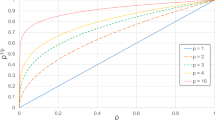Abstract
This paper deals with the analysis and design of tube hydroforming parameters in order to reduce defects which may occur at the end of the forming process, such as necking and wrinkling. We propose a specific methodology based on the coupling between an enhanced one-step method for the rapid simulation of tube hydroforming process and a surrogate model based on a metamodeling technique. The basic formulation of the one-step method has been modified and adapted for the modeling of 3D tube hydroforming problems in which the initial geometry is a circular tube expanded by internal pressure and submitted to axial feeding. In the surrogate model, approximate responses are built using moving least squares method and constructed within a moving region of interest which moves across a predefined discrete grid of authorized experimental designs. Two applications of tube hydroforming of aluminum alloy 6061-T6 have been utilized to validate our methodology. The final design is validated using experiments together with the classical explicit dynamic incremental approach using ABAQUS® commercial code.
Similar content being viewed by others
References
Ahmetoglu M, Sutter K, Li XJ, Altan T (2000) Tube hydroforming: current research, applications and need for training. J Mater Process Technol 98:224–231
Barlat F, Brem JC, Yoon JW, Chung K, Dick RE, Choi S-H, Pourboghart F, Chu E, Lege DJ (2003) Plane stress yield function for aluminum alloy sheets. Part 1: theory. Int J Plast 19:1297–1319
Chebbah M-S, Naceur H, Hecini M (2010) Rapid coupling optimization method for a tube hydroforming process. J Eng Manuf 224(2):245–256
Chebbah MS, Naceur H, Hecini M, Belouattar S (2007) Response surface method for the rapid design of process parameters in tube hydroforming. NUMIFORM’07, Porto, Portugal, pp 455–460
Di Lorenzo R, Ingarao G, Chinesta F (2010) Integration of gradient based and response surface methods to develop a cascade optimisation strategy for Y-shaped tube hydroforming process design. Adv Eng Softw 41:336–348
Fu L, Dong X, Wang P (2009) Study on one-step simulation for the bending process of extruded profiles. Int J Adv Manuf Technol 43(11–12):1069–1080
Guo YQ, Batoz JL, Detraux JM, Duroux P (1990) Finite element procedures for strain estimations of sheet metal forming parts. Int Jnl Num Meth Eng 30:1385–1401
Guo YQ, Gati W, Naceur H, Batoz JL (2002) An efficient DKT rotation-free shell element for springback simulation in sheet metal forming. Comput Struct 80(27–30):2299–2312
Guo YQ, Li YM, Gati W, Naceur H (2003) Sheet forming modeling by inverse approach and pseudo inverse approach with damage effects. Comput Fluid Solid Mech 17–20:304–307
Hosford WF, Caddell RM (2007) Metal forming: mechanics and metallurgy, 3rd Ed. Cambridge University Press, New York, 328 pp. ISBN 978-0-521-88121-0
Imaninejad M, Subhash G, Loukus A (2004) Experimental and numerical investigation of free-bulge formation during hydroforming of aluminum extrusions. J Mater Process Technol 147(2):247–254, ISSN 0924–0136
Jansson M, Nilsson L, Simonsson K (2008) Tube hydroforming of aluminium extrusions using a conical die and extensive feeding. J Mater Process Technol 198:14–21
Kim SW, Song WJ, Kang BS, Kim J (2009) Bursting failure prediction in tube hydroforming using FLSD. Int J Adv Manuf Technol 41:311–322
Korkolis YP, Kyriakides S (2011) Hydroforming of anisotropic aluminum tubes. Part I: experiments. Int J Mech Sci 53:75–82
Manabe K, Amino M (2002) Effects of process parameters and material properties on deformation process in tube hydroforming. J Mater Process Technol 123(2):285–291, ISSN 0924-0136
Myers RH, Montgomery DC (2002) Response surface methodology process and product optimization using designed experiments. Wiley, New York
Naceur H (2010) Optimisation de forme de structures minces en grandes transformations. Edition EUE, 240 pp. ISBN-13: 978-613-1-54700-3
Naceur H, Guo YQ, Gati W (2002) New enhancements in the inverse approach for the fast modeling of autobody stamping process. Int J Comput Eng Sci 3(4):355–384
Naceur H, Ben-elechi S, Batoz JL, Knopf-Lenoir C (2008) Response surface methodology for rapid design of aluminium sheet metal forming parameters. Mater Des 29:781–790
Nayrolles B, Touzot G, Villon P (1992) Generalizing the finite element method: diffuse approximations and diffuse elements. Comput Mech 10:307–318
Nguyen BN, Johnson KI, Khaleel MA (2003) Analysis of tube hydroforming by means of an inverse approach. J Manuf Sci Eng 125:369–377
Nikhare C, Weiss M, Hodgson PD (2010) Die closing force in low pressure tube hydroforming. J Mater Process Technol 210:2238–2244
Numisheet (2008) Part A, Proceedings of the 7th International Conference and Workshop on Numerical Simulation of 3D Sheet Metal Forming Processes (edited by Pavel Hora, ETH Zurich), September 1–5, 2008 Interlaken, Switzerland
Shin YS, Kim HY, Jeon BH, Oh SI (2002) Prototype tryout and die design for automotive parts using welded blank hydroforming. J Mater Process Technol 130-131:121–127, ISSN 0924-0136
Singh H (2003) Fundamentals of hydroforming. Edition Society of Manufacturing Engineers, Dearborn, MI, USA, 219 pp. ISBN-13: 9780872636620
Author information
Authors and Affiliations
Corresponding author
Rights and permissions
About this article
Cite this article
Elie-dit-cosaque, X., Chebbah, M.S., Naceur, H. et al. Analysis and design of hydroformed thin-walled tubes using enhanced one-step method. Int J Adv Manuf Technol 59, 507–520 (2012). https://doi.org/10.1007/s00170-011-3539-4
Received:
Accepted:
Published:
Issue Date:
DOI: https://doi.org/10.1007/s00170-011-3539-4




